Facebook Best Practices for a Bulletproof Strategy
Discover essential Facebook best practices to enhance your engagement, boost visibility, and optimize your social strategy for success.


Alright, I’ll get straight to it.
If you’re still using old-school Facebook tactics, you’re leaving results on the table.
I know you don’t have time for “good enough” anymore. You need a strategy that delivers.
So let’s explore the top Facebook best practices that go beyond the basics and actually drive real impact.
Key takeaways
- How does Facebook’s algorithm work today? Facebook’s algorithm now rewards authentic, conversation-driven, and native content that builds real connections with users.
- Best practices for optimizing different content formats on Facebook: Tailor your videos, visuals, and text posts to match audience behavior—short, emotional videos, authentic user-generated visuals, and interactive text posts drive the best engagement.
- Platform specific features and engagement optimization best practices: Maximize engagement by using Facebook-native features—Groups, Stories, and Reels—to spark real-time conversations and build stronger community connections.
- Facebook content creation and measurement best practices: Balance valuable and promotional content, track key performance metrics, and use external analytics tools for a data-driven, competitive Facebook strategy.
How does Facebook’s algorithm work today?
If you’ve noticed your Facebook posts performing better lately, you’re not imagining it.
According to a Socialinsider study, Facebook engagement climbed by 18% in the first half of 2025. This is proof that the platform’s algorithm is rewarding the right kind of content again.
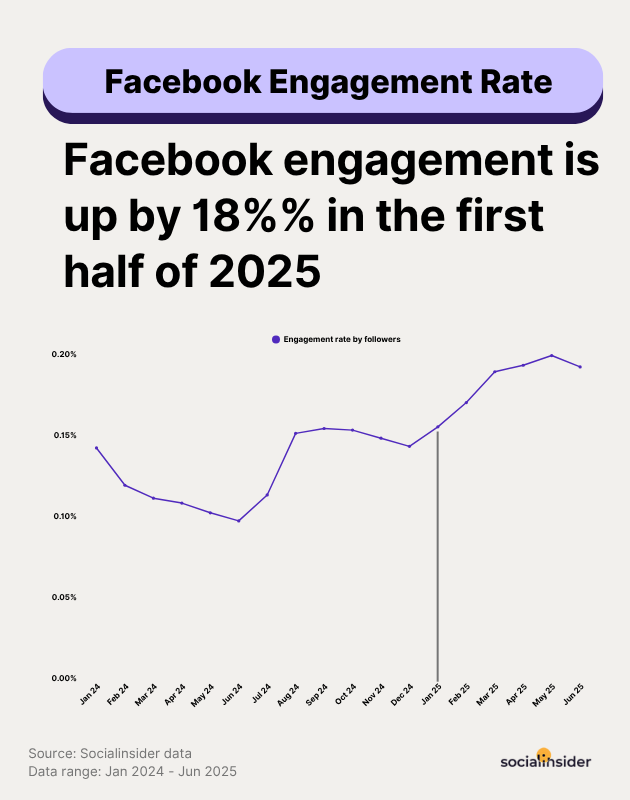
So, what’s changed? In short: quality and intent.
Facebook’s algorithm has become smarter at predicting what users *actually want to see*, not just what they interact with out of habit.
It now prioritizes:
- Authentic engagement over vanity metrics. Shares, saves, and meaningful comments carry far more weight than likes.
- Content that sparks conversation. Posts for Facebook that trigger back-and-forth interactions (especially early on) are boosted higher in feeds.
- Native formats. Facebook still favors content created within the platform: Reels, photo carousels, or text-based posts, over external links.
- User relationships. The closer someone is to your brand (followers who message, comment, or react often), the more likely they’ll see your future posts.
In other words, the algorithm’s not working against you. It’s laser-focused on rewarding Facebook content types that feel personal, relevant, and real.
Best practices for optimizing different content formats on Facebook
Whether it’s video marketing, images, or text, I’ve got the social media tactics you need to create social media content that truly resonates.
So let’s get to work and uncover the best practices on Facebook for each content format.
Video content best practices for Facebook
Let me start with these Facebook video best practices that will help you optimize your video marketing strategy for both views and engagement:
Create videos according to data-backed best-performing video lengths
Video length matters more than you think.
And according to our study on social media benchmarks, videos under 30 seconds and in the 60-90 second range pull strong view counts.
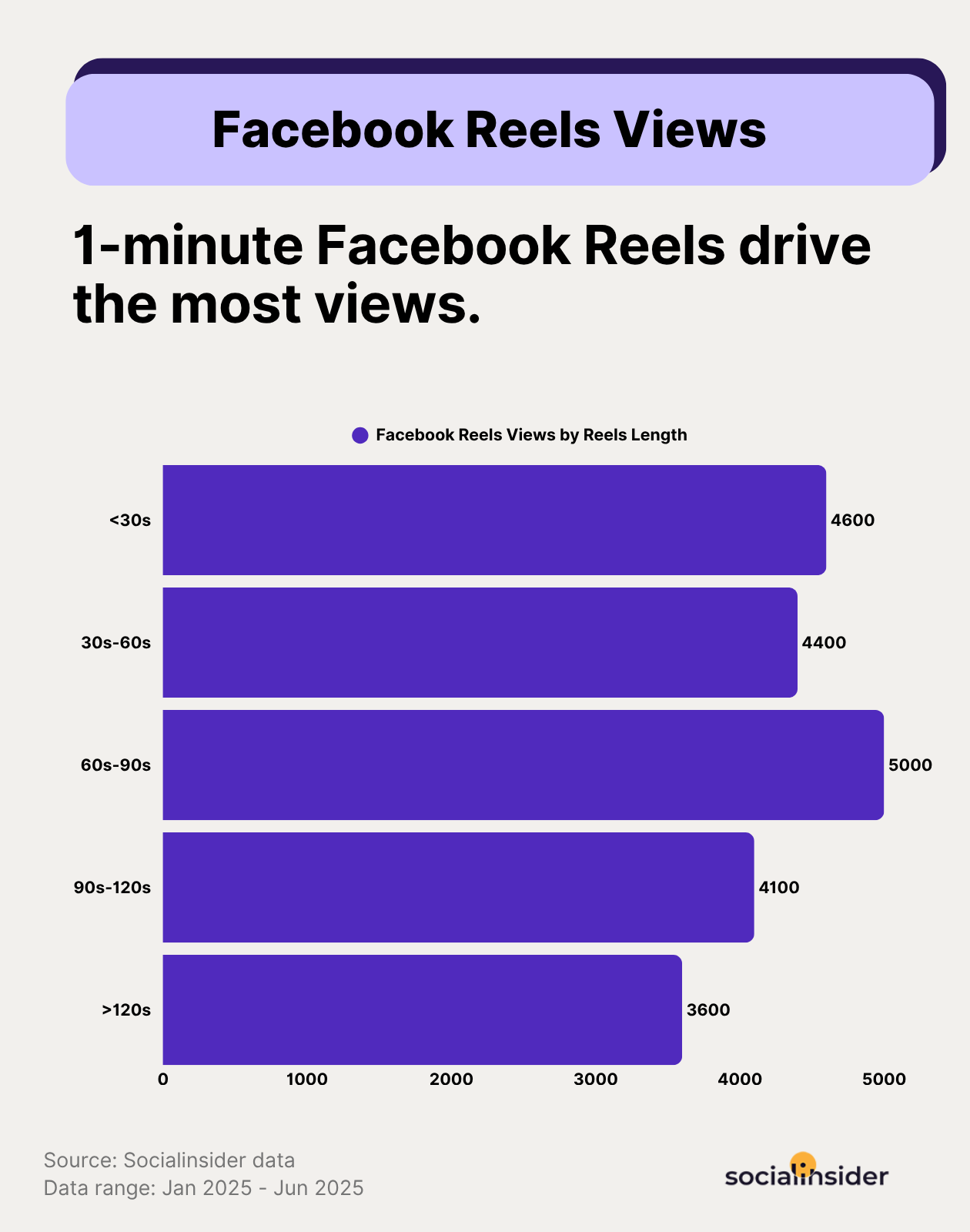
But here's the twist: 90-120 second videos drive the highest engagement rates.
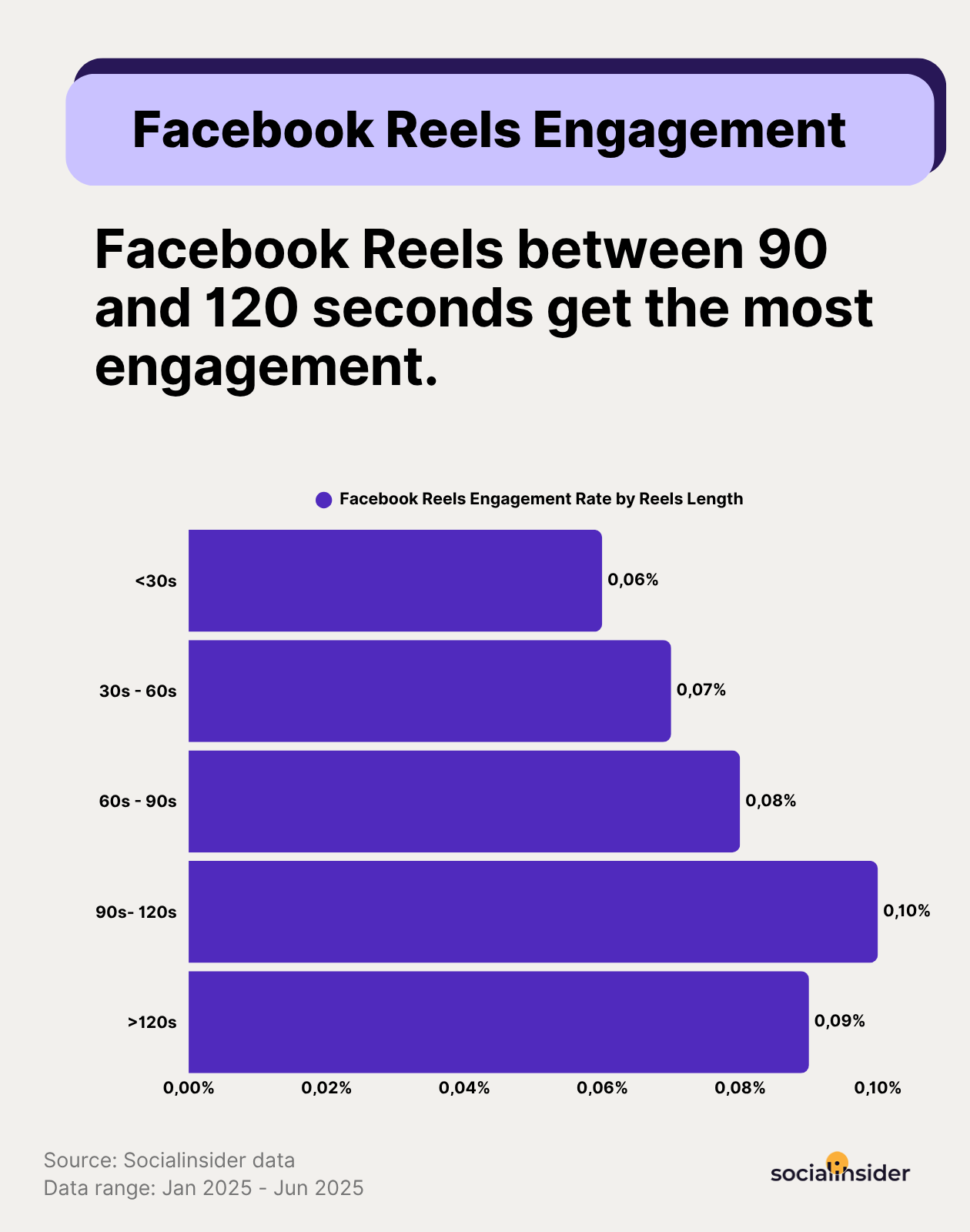
If you ask me, I'd say the sweet spot is the 90-second window, giving you enough time to hook viewers, deliver real social media value, and create a complete narrative arc without losing your audience's attention.
Use emotional triggers to drive shares
Views are great, but shares?
That's how your content spreads. And shares happen when you tap into genuine emotion. Real customer stories, behind-the-scenes moments, or relatable struggles resonate far more than polished, scripted content.
Trust me, when viewers see themselves in your video or feel something real, they get compelled to pass it along.
Visual content best practices for Facebook
I'm sure that one and off, you're wondering what to post Facebook moving forward, right?
Well, we know visuals are the heartbeat of Facebook engagement.
So, to truly stand out in a crowded feed, make sure you:
Leverage UGC campaigns
Invite your audience to share authentic, personal moments with your brand.
User-generated content amplifies trust, sparks genuine conversations, and not only gives your social media community a voice but also fuels your visual content with fresh, relatable perspectives.
Double down on albums
One of our Socialinsider studies reveals that albums are currently driving the highest engagement on Facebook, with images coming in second.
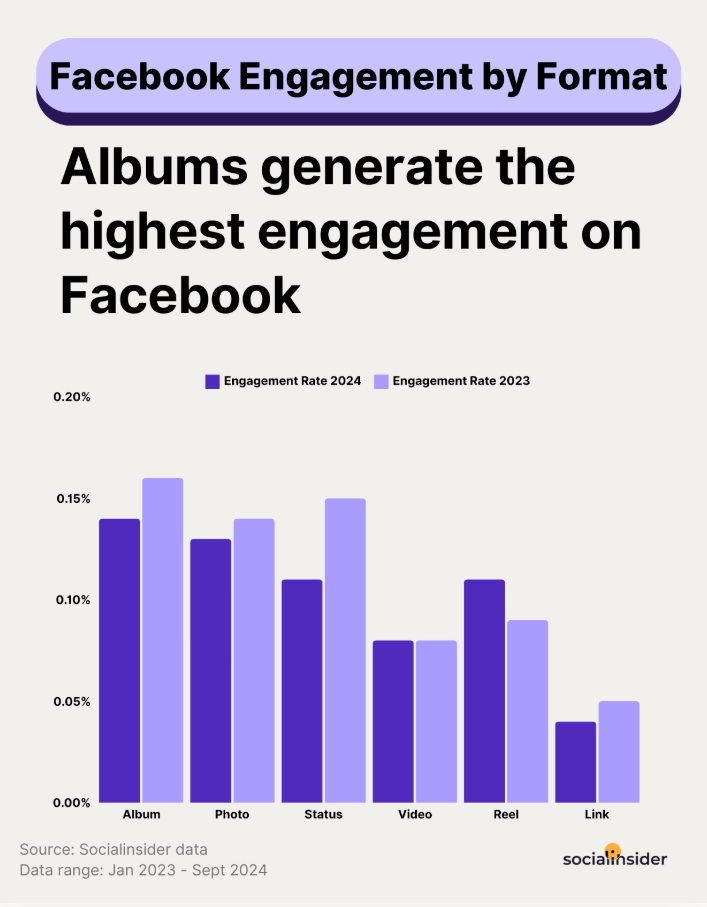
A good social media manager knows that albums offer a powerful way to showcase events, company culture, or product stories by grouping visuals into cohesive narratives that encourage followers to explore more.
Text posts best practices for Facebook
So, what are the Facebook posting best practices to ensure your text stands out?
Let’s dive into the essentials:
Use interactive posts such as polls & questions
One powerful takeaway from our competitive analysis on Facebook, including insights from leading industry voices, is the success of interactive content.
Text posts with simple backgrounds and open-ended questions on Facebook consistently drive higher engagement levels.
These types of Facebook posts allow brands to spark conversations with their audience, making it more likely that people will engage.
Here's an insight our CMO, Adina Jipa, offered in an interview:
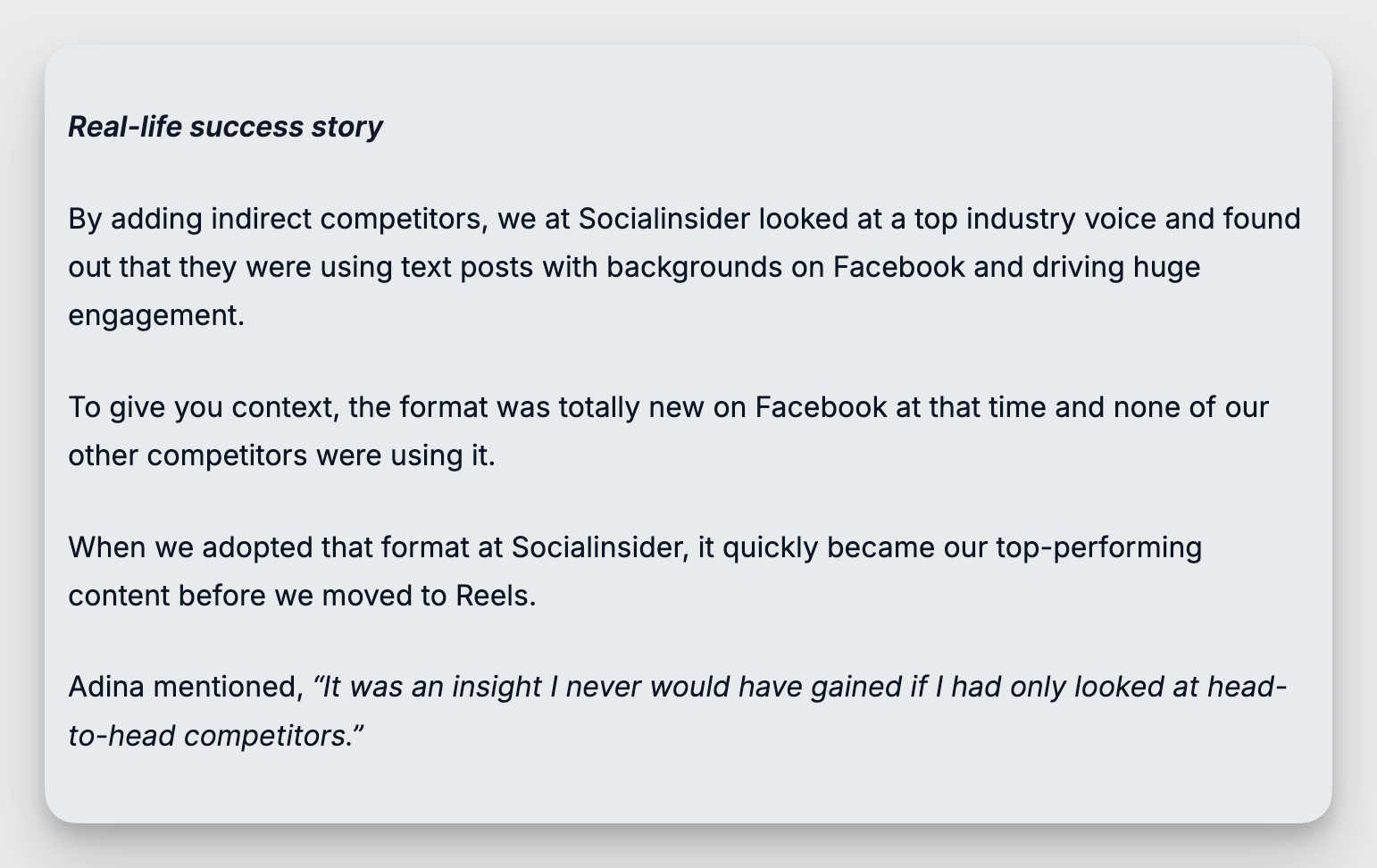
Additionally, incorporating polls can also amplify this engagement as they provide instant feedback.
Have an optimized posting strategy
Posting frequency and timing matter.
According to our research on how often to post on social media, brands that post about 5 times a week tend to see the best results.
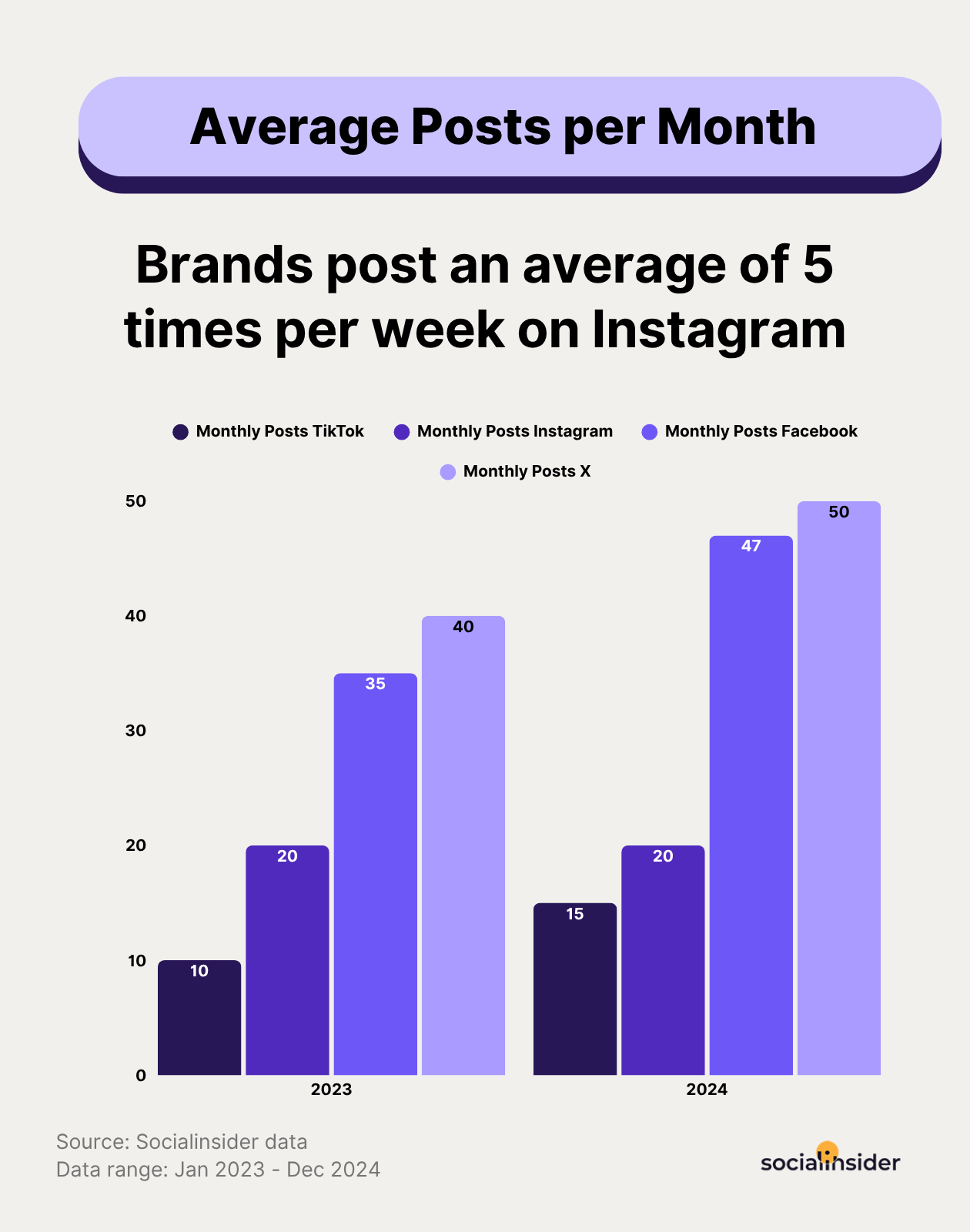
But remember, the key is finding the right balance: post often enough to stay in your audience’s feed, but not so much that you risk fatigue or a drop in engagement.
BONUS:
- How to structure text for maximum readability
For text posts to perform well, the structure is crucial.
Using short paragraphs, clear language, and bullet points or numbered lists to break up long blocks of text are just a few social media optimization tips you can use to make your post easier to read.
- When text-only posts outperform visual content
While visuals are powerful tools, there are times when text-only posts outperform images or videos.
Simplicity can work in your favor. In certain situations, text posts allow for deeper engagement, especially when you want to focus on delivering a message or starting a conversation.
Moreover, pairing images with your text can enhance the message, making it more dynamic.
For example, when posting on Facebook, consider adding subtle, relevant images to provide context to your posts. This can enhance your audience's connection to the content, without overshadowing the primary message.
Platform specific features and engagement optimization best practices
So, you want your social media campaigns to stand out on Facebook?
Well, if you're asking what the secret is, I'd tell you it’s all about understanding each platform’s quirks and using them to your advantage.
With a bit of know-how and some solid social media marketing strategy, you’ll be making waves and building an engaged community in no time.
Let me break down some easy-to-follow tips for creating engaging posts on Facebook.
Facebook groups best practices
Facebook Groups are where the magic happens. They’re your community’s home base.
But don’t just throw up a group and expect it to grow on its own.
Here’s a few Facebook group best practices to keep them buzzing:
- Spark conversations: Don’t just drop links or promo material. One thing that I constantly do is to ask questions, run polls, and share content that gets people talking. The key is to make sure your posts encourage replies. Trust me, the more interaction you create, the more invested your members will be.
- Consistency over perfection: You don’t need to post every hour, but you do need to post regularly. Keep the momentum going by scheduling posts that mix it up. Discussion starters, helpful tips, and personal insights. Your members will expect it, and they'll look forward to the next one.
- Give VIP access: One of the Facebook best practices I've tested myself was to reward group members with exclusive content, such as sneak peeks, behind-the-scenes action, or first dibs on a special offer. And guess what I've discovered - when people feel like they’re in the know, they’re more likely to stick around.
- Be a real human: Engage personally. Respond to comments, react to posts, and show you’re there for more than just selling. A real connection goes a long way.
Facebook Stories best practices
From experience, I can tell you Stories are one of the best types of content to post on Facebook and a perfect way to connect with your audience on a daily basis.
Here’s how to keep them coming back for more:
- Keep it real (literally): Stories are less about polish and more about authenticity. Think of them like a quick chat with a friend. Share your real-time moments, whether that’s a new product drop, something funny happening in the office, or a cool life hack. Keep it light, fun, and human.
- Use interactive features: Polls, questions, and countdowns are your best friends when it comes to Stories. They keep people engaged and give them something to interact with. Make them feel involved.
- Be consistent (but not overwhelming): No one likes a story spammer, but consistency does matter. Try to stick to a rhythm that fits your brand: daily, weekly, or on special occasions.
- Short, sweet, and snappy: Stories should be bite-sized and to the point. Keep them quick and impactful. Focus on visuals. People are scrolling fast, so make your content stop them in their tracks with something eye-catching.
Facebook Reels best practices
If I haven't told you this before, well, now's the time - Facebook Reels are your chance to show off your creative side
But with a 90-second time window (as we've already seen, this is the best duration), you must ensure you make it count. Here’s how:
- Hop on trends: Trendy sounds, challenges, or memes are great, but you don’t need to follow the crowd exactly. Put your own twist on trending topics. Make it relevant to your audience, and make it fit your style.
- High-quality visuals and sound: This one’s a no-brainer. People scroll past low-quality videos faster than you can say “content creator.” Keep your visuals sharp and your sound crisp. And don’t forget to make the first few seconds of your Reel grab attention. You have about 3 seconds before people lose interest.
- Text is your friend: Make sure your message is clear, even if the viewer isn’t listening to the sound. Use text overlays to emphasize your point or give context to your visuals. It helps people connect with your message, even on mute.
- Play with timing: While it’s tempting to stretch a Reel to its max 90-second limit, sometimes shorter is better. People tend to watch shorter Reels all the way through. My advice? Test different lengths and see what keeps your audience glued to the screen.
Facebook content creation and measurement best practices
Creating content that not only grabs attention but also keeps your audience engaged can feel like a juggling act, I know.
But fear not.
Nailing your social media content strategy is easier when you know the right balance, the right pillars, and the right time, trust me.
Use the 80/20 content strategy
- Balance promotional vs. valuable content
When it comes to Facebook, a good rule of thumb is the 80/20 rule.
In other words, 80% of your content should add value to your audience—whether it’s educational, entertaining, or just downright inspiring.
The remaining 20%?
That's your promotional content. No one likes being hit with constant ads, so make sure your audience gets to know your brand first and foremost through meaningful content.
- Discover the content pillars that build loyalty
Take it from me, building audience loyalty starts with understanding what content resonates most.
It’s not just about what you post, but how consistently you post content that truly connects with your audience.
Luckily, Socialinsider can help you identify the most engaging types of posts on Facebook. Not only for your own brand but also for your competitors.
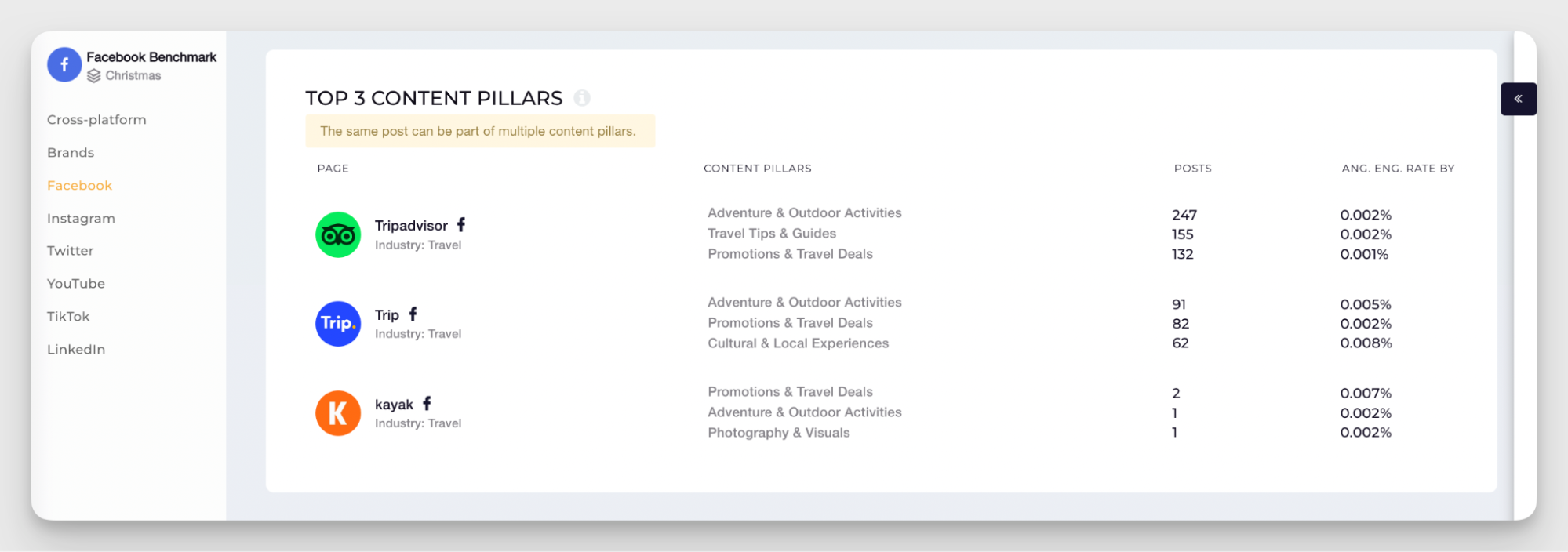
Take Tripadvisor, for example.
In the image below, you can see that their content consistently focuses on high-engagement topics like Adventure & Outdoor Activities and Travel Tips & Guides.
These specific social media content pillars have proven to resonate with their audience, driving interaction and loyalty.
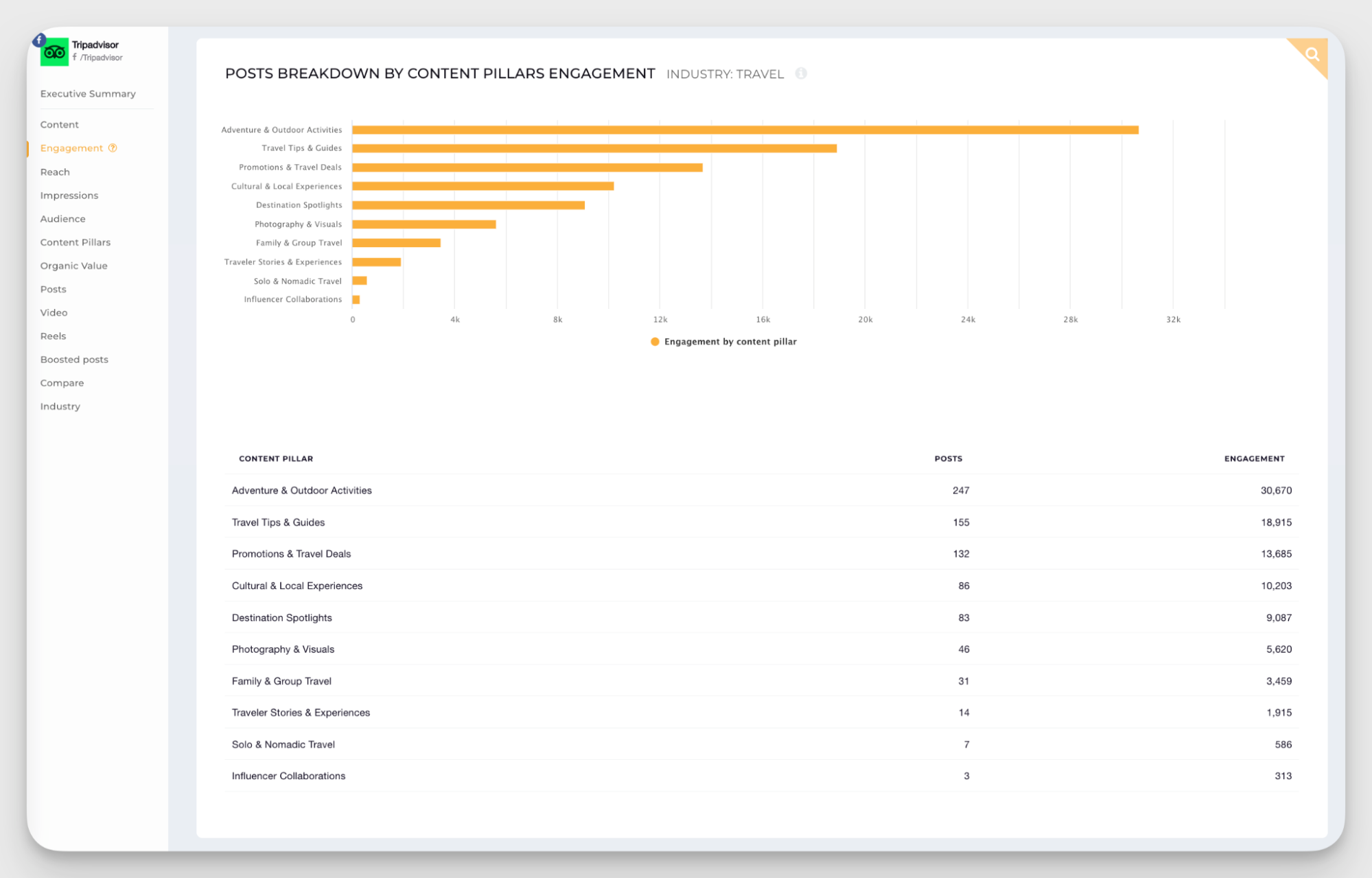
Thus, by leveraging Socialinsider's AI insights, you can uncover these content trends for your brand, just like I did, to ensure you're always sharing what your audience is most likely to engage with.
- Leverage seasonal content planning for sustained engagement
Lastly, don’t forget about the power of seasonal content.
Whether it’s gearing up for the holidays, offering post-vacation deals, or highlighting “Summer Escapes,” seasonal themes work wonders for timely, relevant engagement.
Plan ahead for key dates, and tailor your content to the seasons. It’s the easiest way to keep your audience coming back for more.
Important metrics to track
To truly understand how your content is performing, you need to focus on a handful of key brand metrics.
Follower growth
A steady increase in followers means your content is resonating with people.
It’s like getting a virtual high-five every time you post something that clicks.
But if your follower count starts stagnating or dipping, it’s a sign to rethink your strategy.
Let me exemplify, moving forward with TripAdvisor’s case study, which, in this case, is a positive one. An analysis of the brand's follower growth demonstrated how strategic content can drive followers over time.
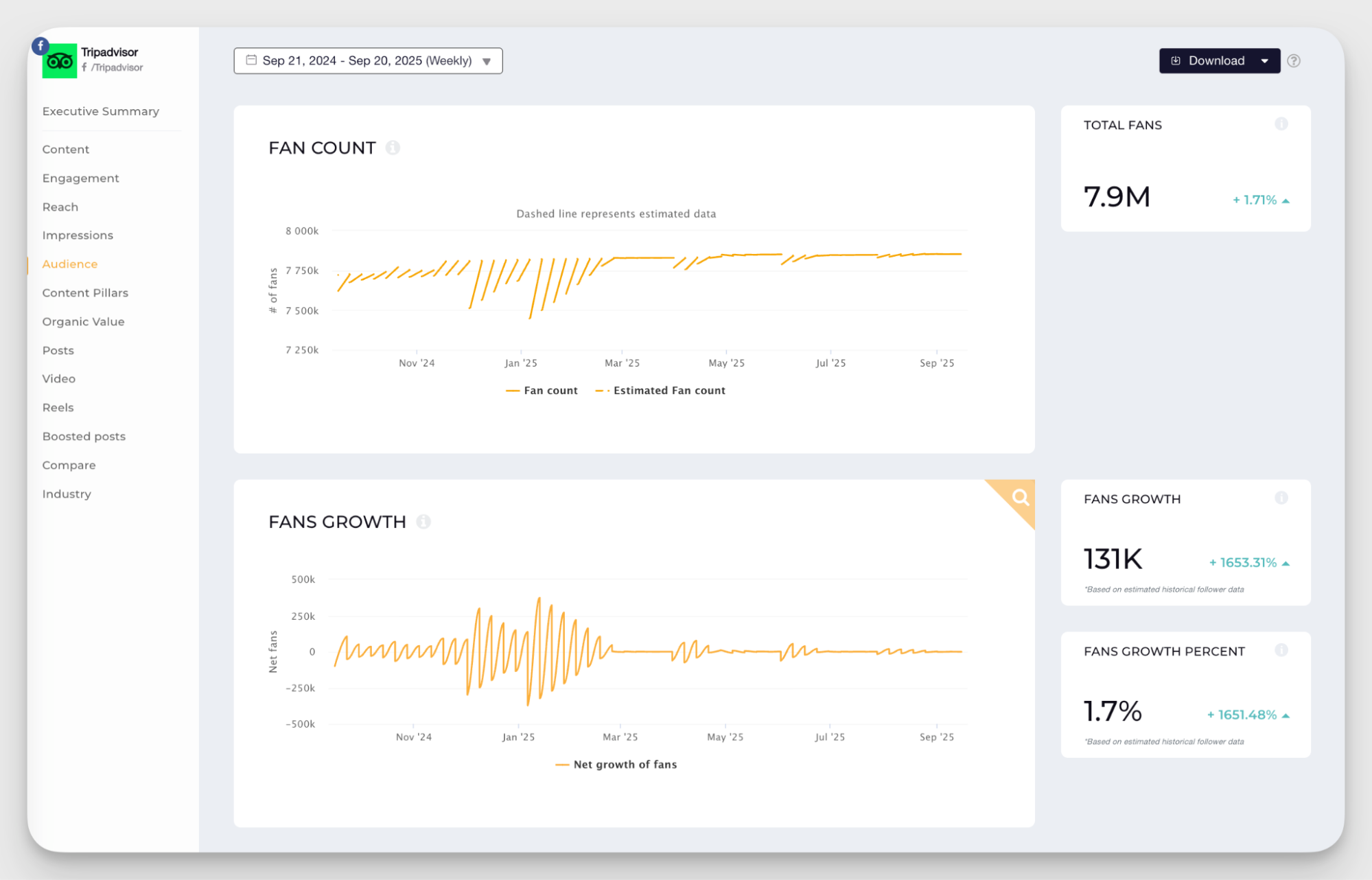
Reach, impressions, views, and engagement
These are your bread and butter when it comes to gauging content performance.
Below, I've run a quick rundown of these social media analytics:
- Reach: how many unique people saw your posts
- Impressions: how often your content was shown to those people
- Views: the number of times your videos were actually watched
- Engagement: all the interactions—likes, shares, comments—your content gets
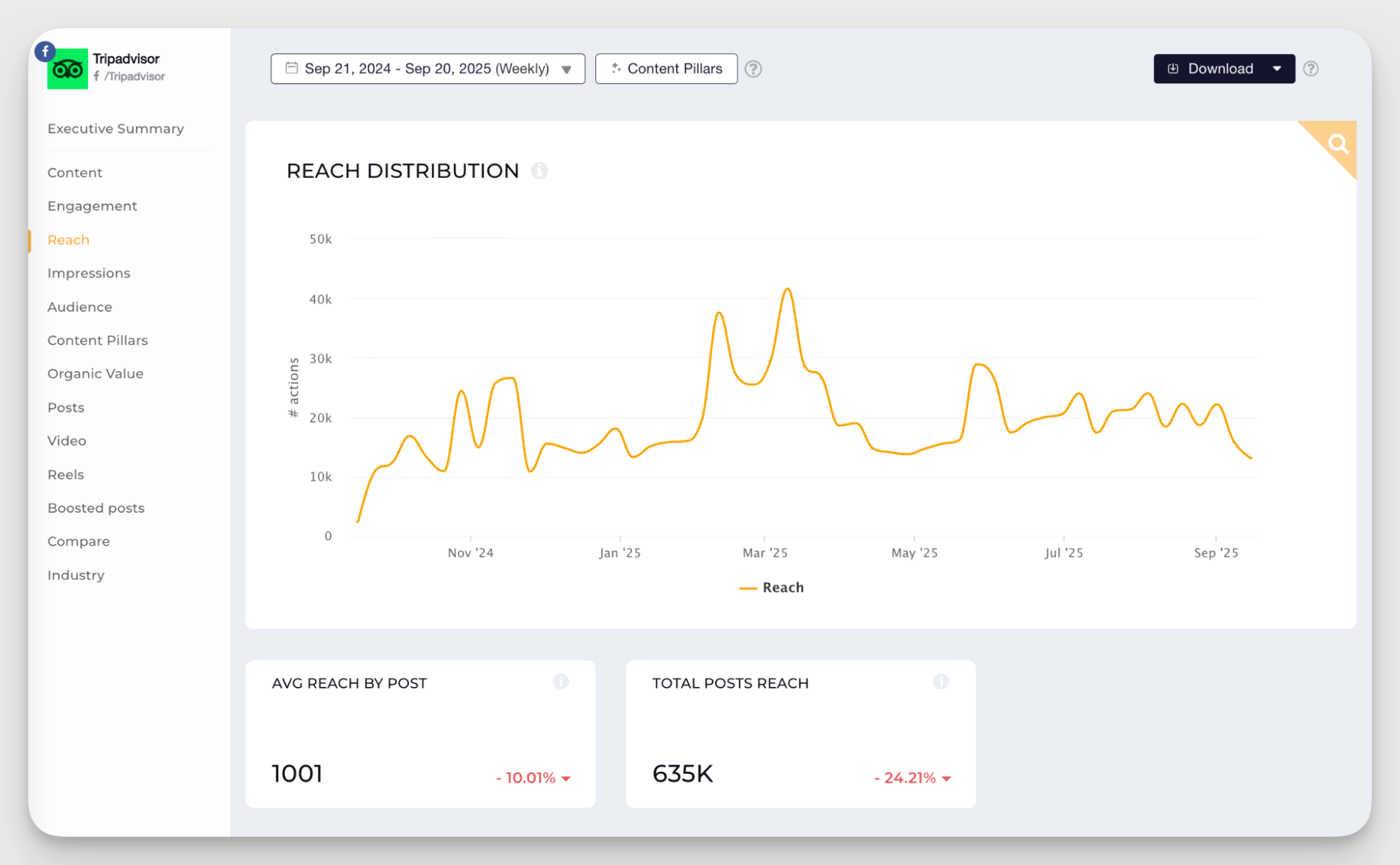
Tripadvisor’s reach vs. impressions distribution graph below clearly shows how these metrics provide a deep dive into how your content is spreading.
A high reach with low engagement? Maybe it's time to rework your content to spark more interaction.
Comments and shares
If you ask me, comments and shares are where the gold is.
When people comment, they’re engaging, connecting with your message. And when they share? That’s the ultimate compliment. Shares mean your content is so good that people want to spread it to their own networks.
Take a look at Trip.com’s spikes in comments and shares in the graph below.
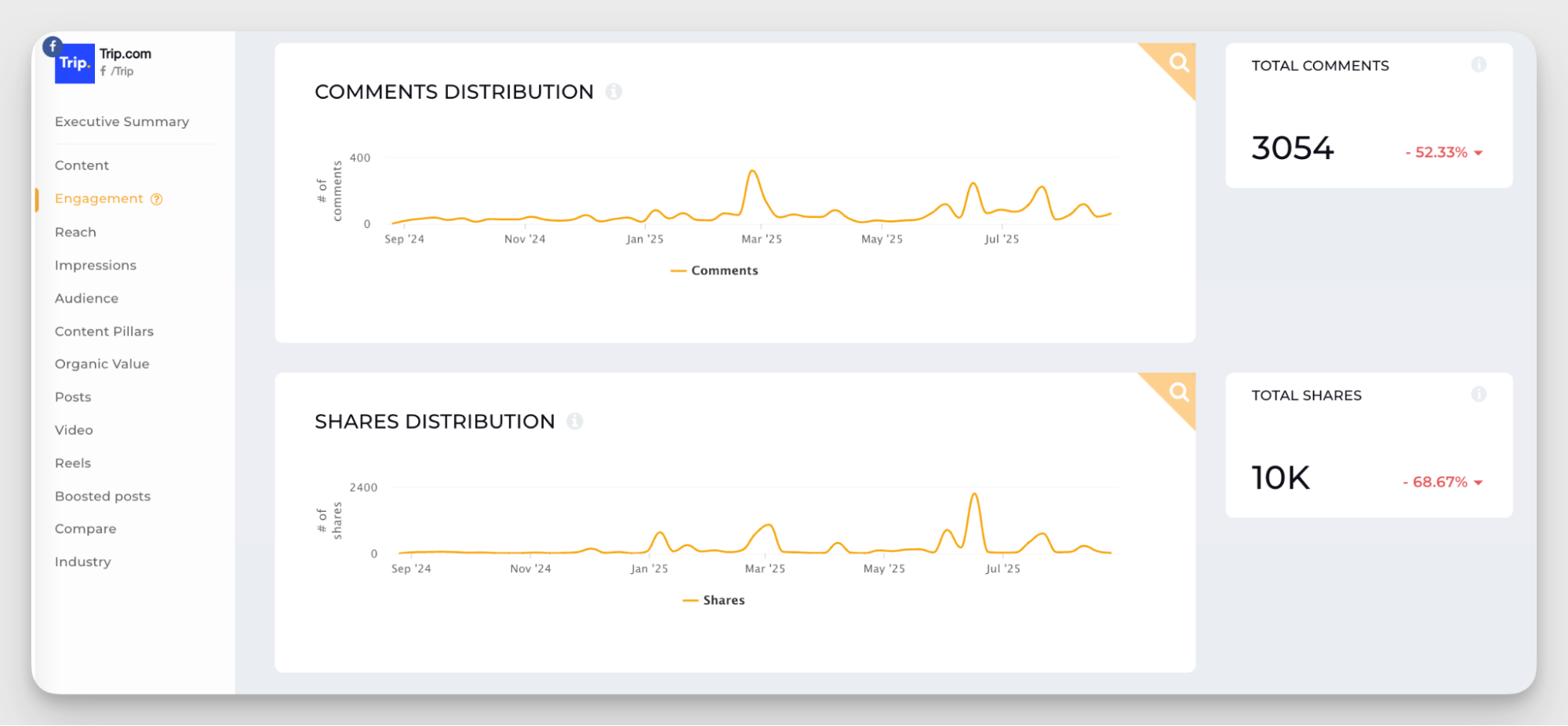
These peaks show us that certain posts are sparking deeper engagement.
Watching for these trends lets you refine your content to maximize those moments of high interaction.
Here's how Jameka Christy, freelance social media manager approaches metric tracking:
With Facebook, I pay extra attention to things like post reach, shares, and link clicks since a lot of traffic and engagement can come from those.
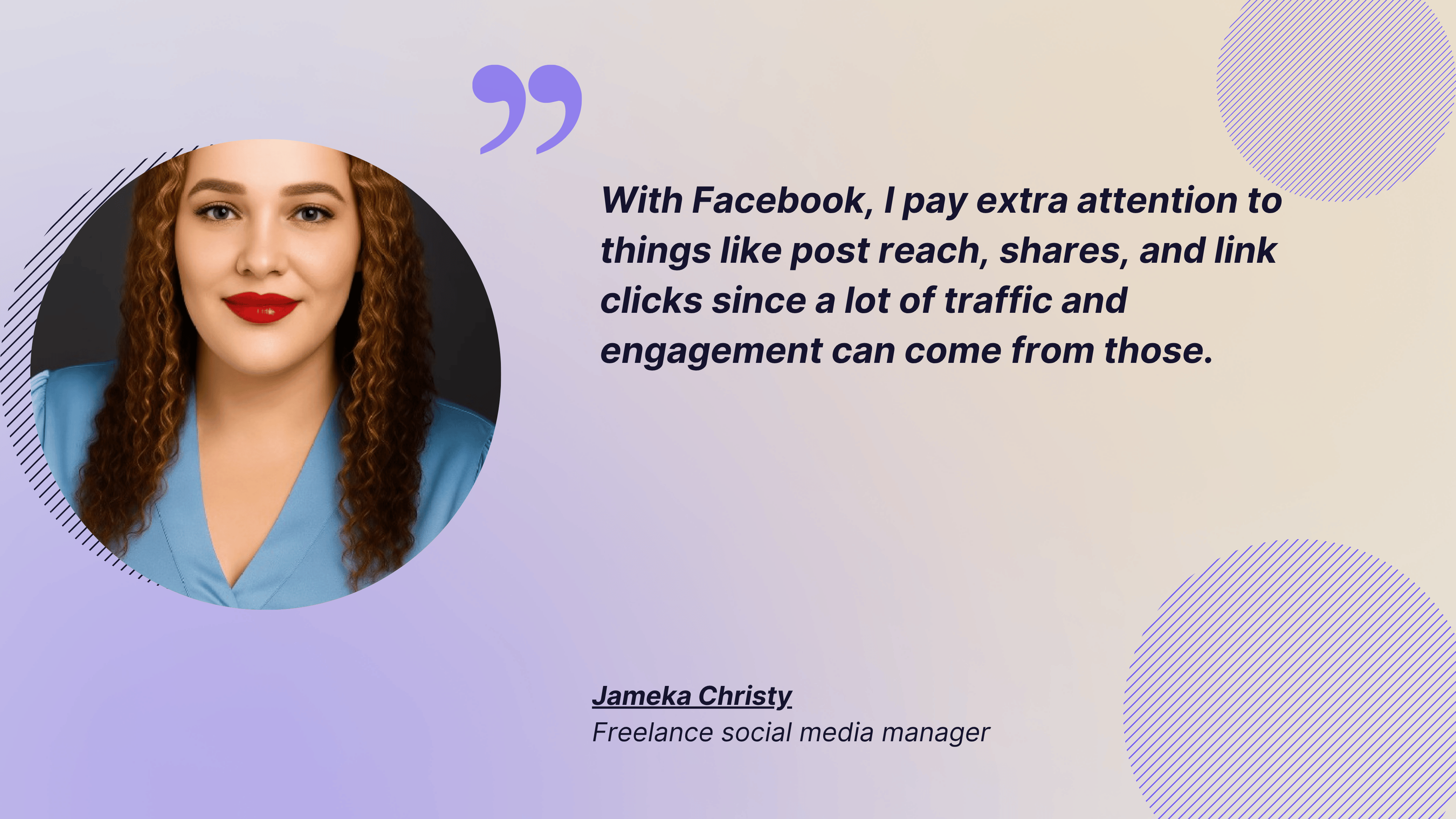
Organic value
Now, let’s talk organic value.
This social media metric is your best friend when it comes to proving the power of your social media marketing efforts. It's actually one of my favorite metrics to analyze.
Why? Because it actually shows how impactful organic content can be, highliging that ads are not always the most powerful tactic.
Here's another interesting insight Jameka gave me when I asked her about the importance of paid vs organic social media:
Sometimes, organic content is already strong and just needs a little amplification, while other times, paid ads are carrying most of the weight. Comparing the two helps me figure out where the real opportunities are, whether that’s creating more engaging organic content or adjusting the paid strategy to get a better return.
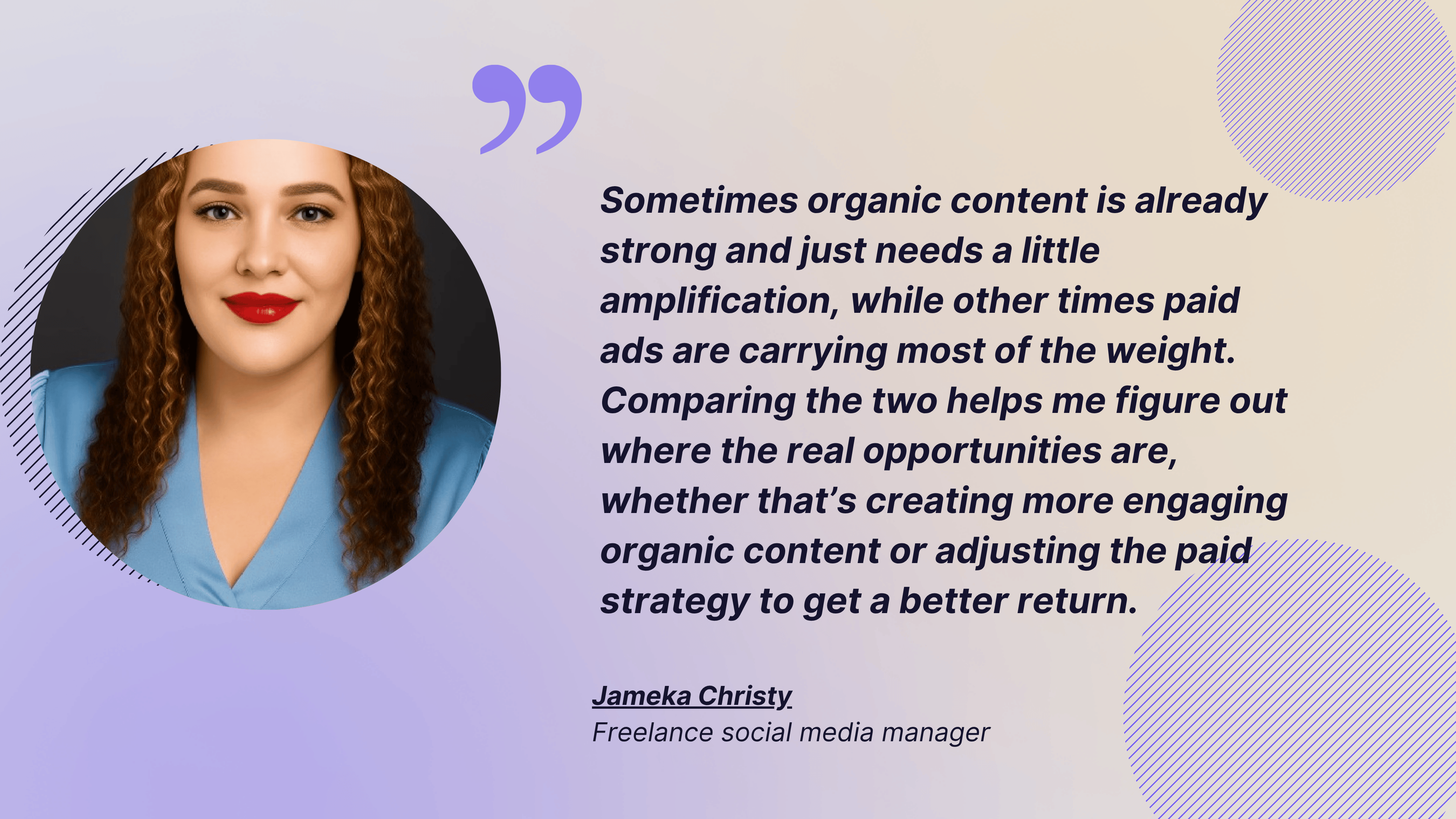
When you see high organic value, naturally, it means your audience is loving your content naturally. They’re sharing, commenting, and engaging because your content is genuinely connecting with them.
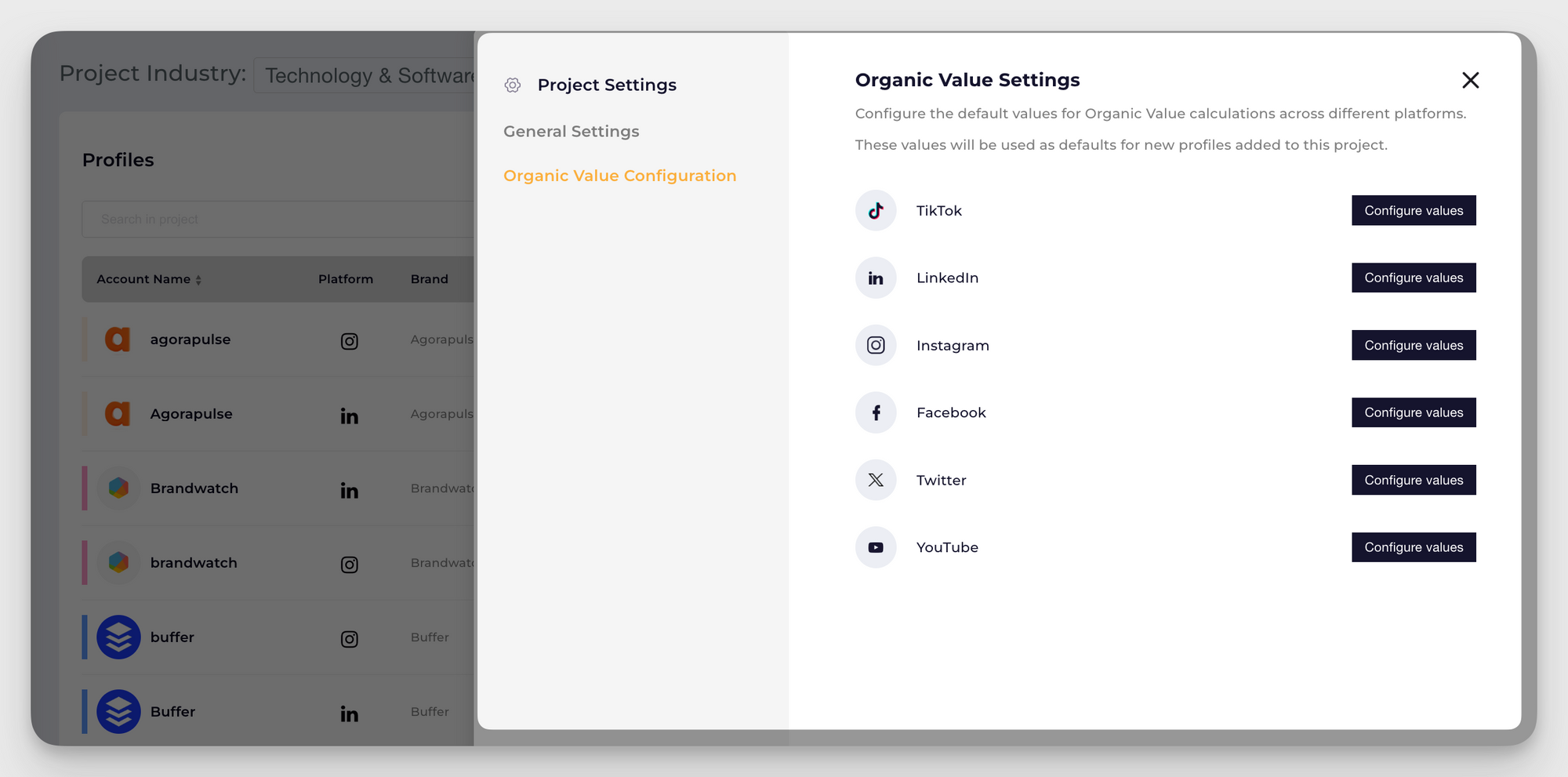
When should Facebook Insights be complemented with external analytics tools?
Facebook Insights is a great start, but it doesn't always give you the full picture.
To truly elevate your social media strategy, my advice is to go beyond what Facebook itself can offer and optimize data collection.
For in-depth insights
External competitive analytics tools offer detailed, actionable insights that allow you to optimize your content, spot trends, and beat the competition.
Here’s why I see them essential for social media success:
Discover the best content formats based on engagement
Figuring out what truly drives engagement? It’s an art.
External tools like Socialinsider provide a deep dive into which content formats (whether videos, photos, status updates, or Reels) deliver the highest engagement.
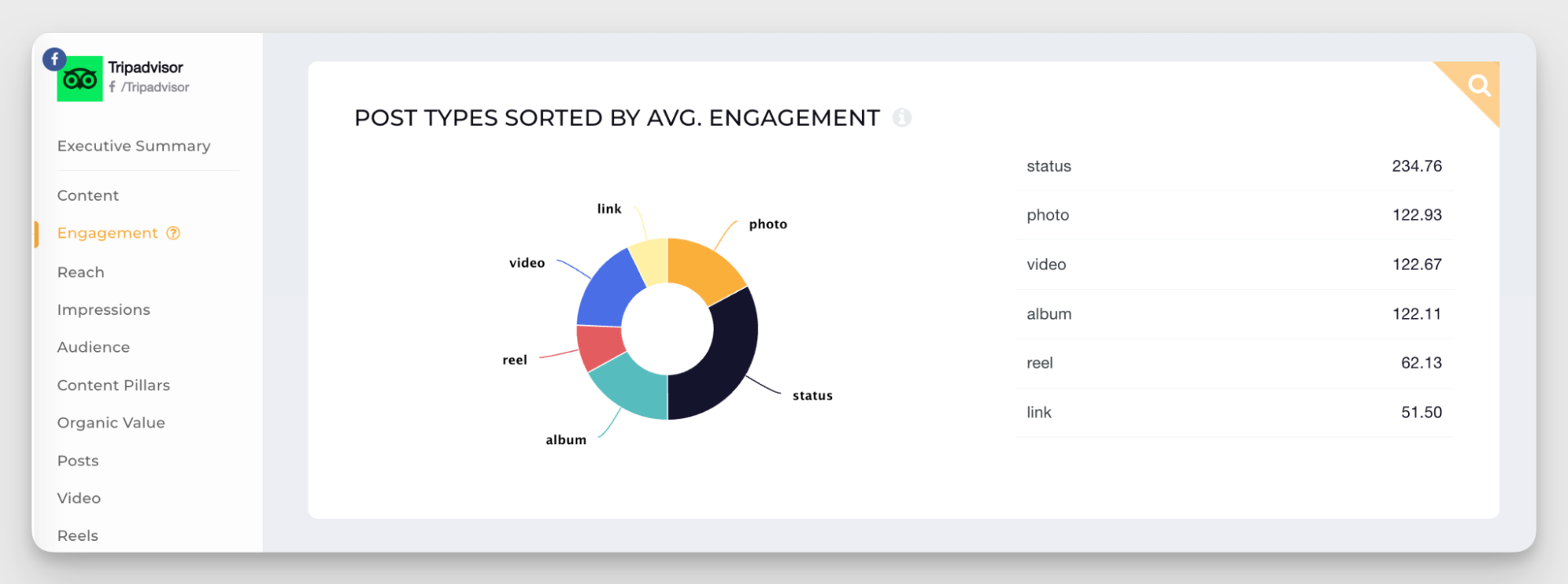
With this knowledge, I can focus on producing the Facebook post types that resonate most with my audience.
Imagine discovering that videos consistently outperform images, enabling you to double down on video production for even better results.
Top and bottom posts
With external tools, I can easily identify what type of posts work best on Facebook. The ones that captured my audience’s attention and sparked conversations.
Equally important is recognizing the bottom-performing posts. Those that missed the mark.
This valuable comparison allows me to understand what resonates with my brand's followers and what doesn’t, helping me fine-tune my content.
Let's move forward with the Tripadvisor example.
When looking at the top and bottom posts for this brand, I could see that their audience is more responsive to Travel Tips than Promotions, signaling that a shift toward more engaging, value-driven content would make a great idea.
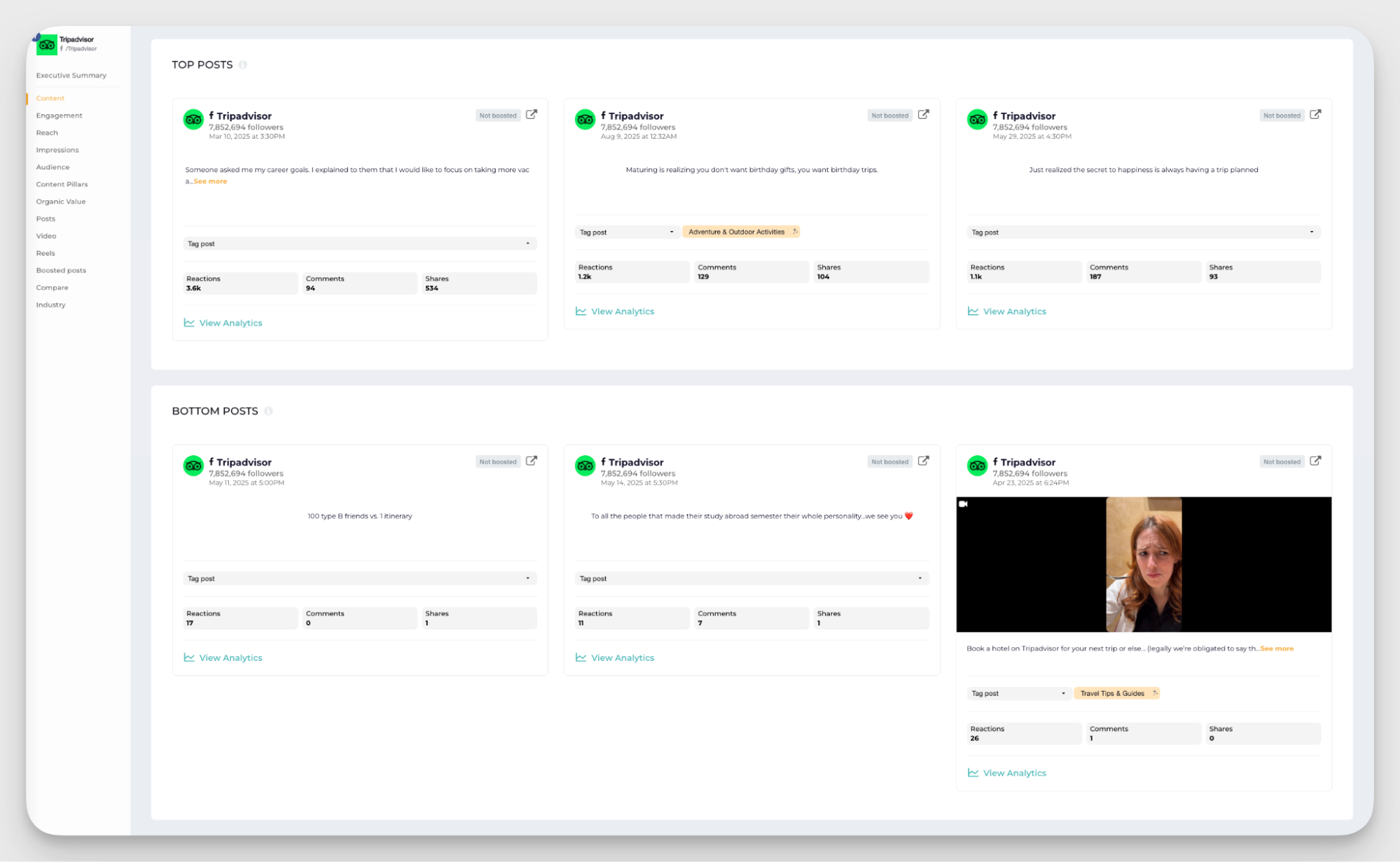
Best time to post by engagement
Timing is everything when it comes to social media.
While Facebook Insights can tell me how my content is doing, external analytics tools show me the best times to post to maximize engagement.
These tools analyze historical data and engagement patterns to pinpoint the specific times and days your audience is most active.
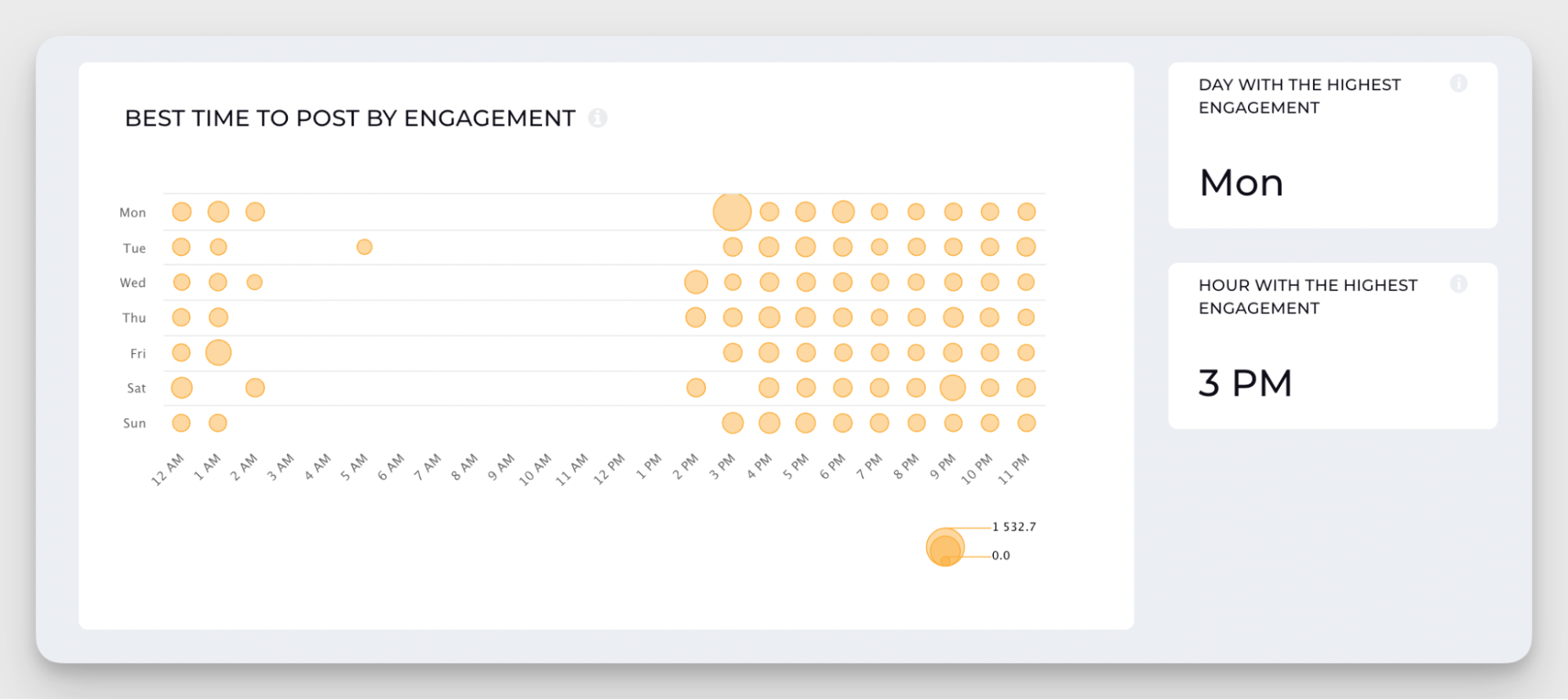
Now that you know that, you can schedule your posts for those peak times and ensure your content grabs people’s attention.
For competitive benchmarking
While Facebook gives you great insights into your own content performance, it’s tough to estimate how you’re doing relative to your competitors.
External Facebook analytics tools provide competitive benchmarking, tracking your competitors' performance and content strategies side by side with yours.
For instance, you can see exactly how brands like Tripadvisor, Trip, and Kayak compare in terms of social media KPIs such as reach, engagement, and content output.
The Facebook competitive analysis I ran below is a perfect example of how you can spot strengths and weaknesses in your approach when compared to industry leaders.
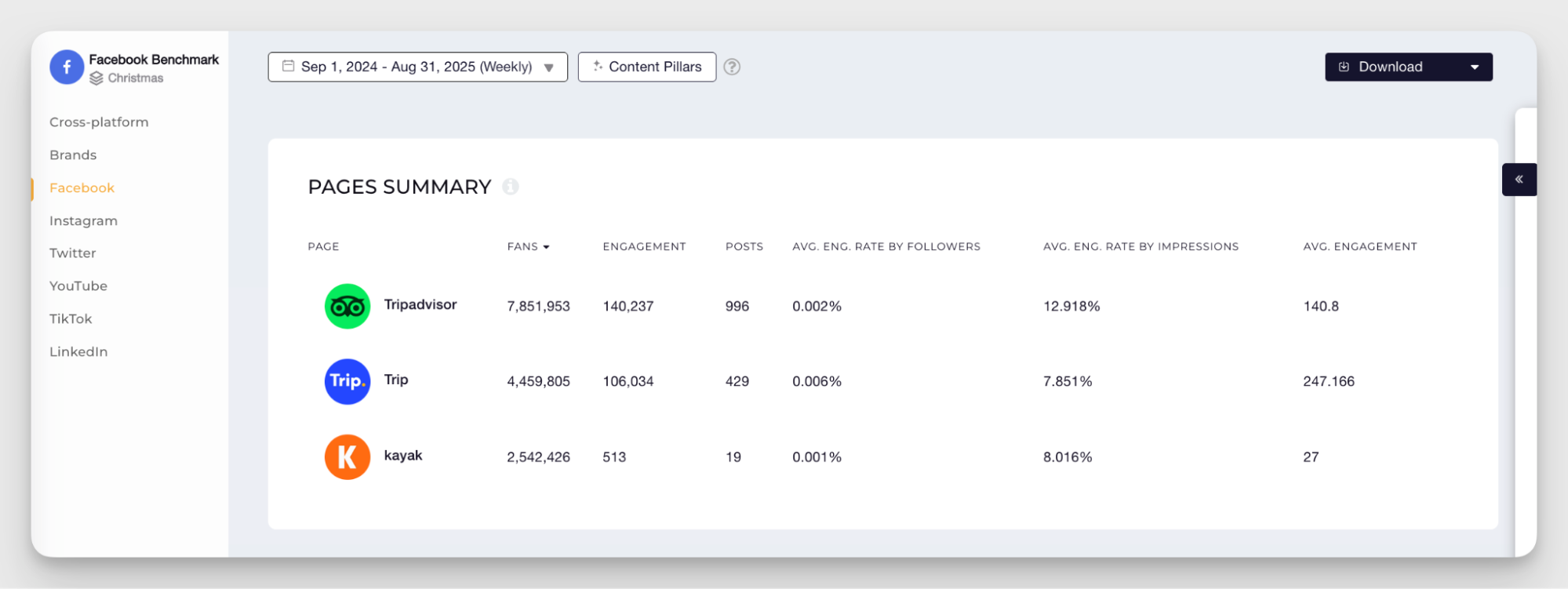
By leveraging external analytics, you’ll not only get the big picture but can use competitive insights to refine your approach.
And here's a piece of advice Kassandra Quinn, social media strategist, had for me, and I feel like sharing with you:
Competitive data is helpful but it’s not the whole story. I like to know what others in the space are doing, especially if we’re benchmarking. It can give you insight into trends, tone, and how other brands are positioning themselves.
That said, I treat it as context, not the blueprint. Just because a competitor is posting five times a week or using a certain format doesn’t mean it’s right for your brand.
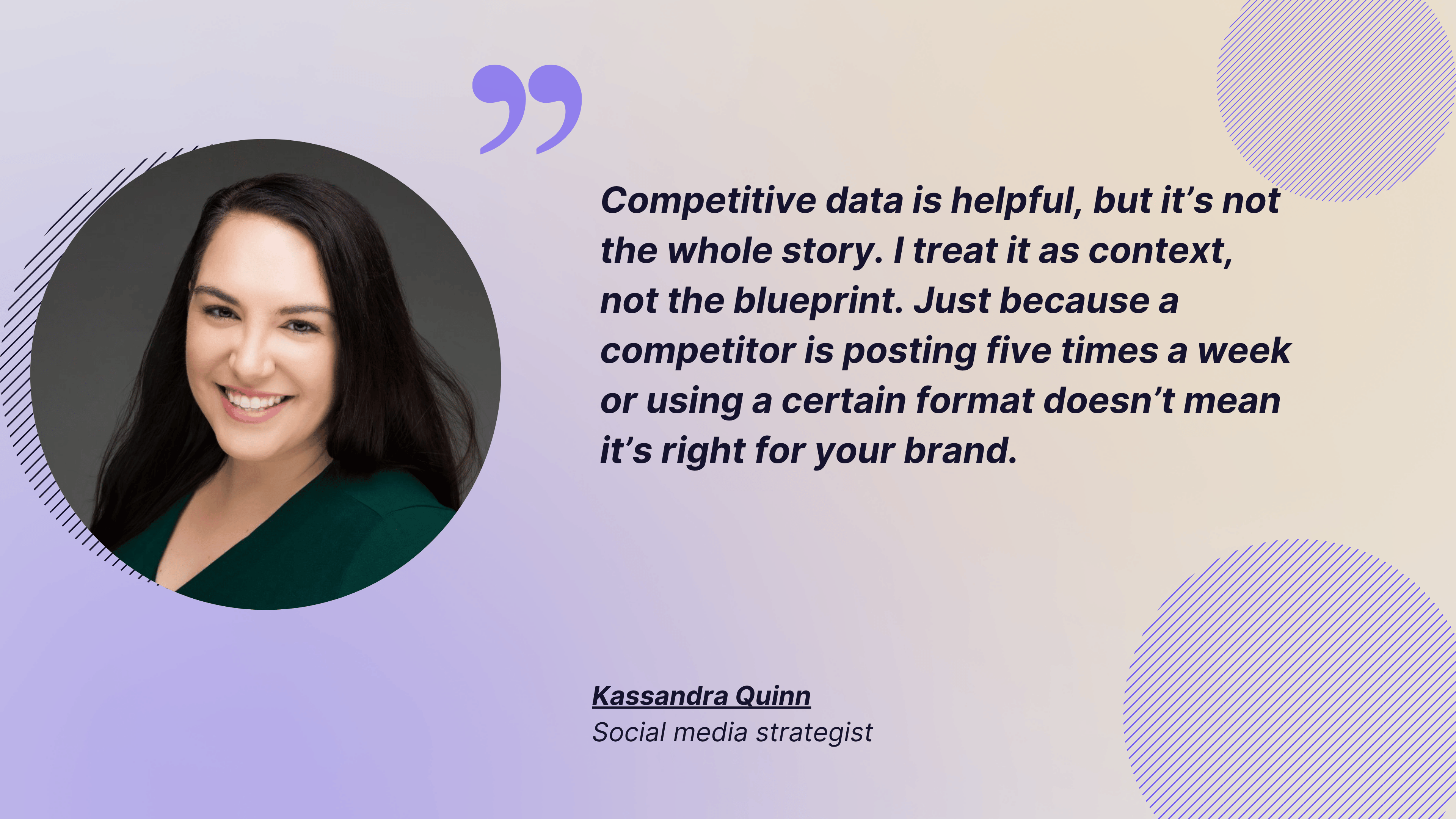
Final thoughts
Well, we can now surely say that cracking the Facebook code isn’t a game of chance, but smart strategy.
By understanding what type of content performs best on Facebook—from authentic posts to engaging formats—you can elevate your content from “meh” to unmissable.
With the right tools and insights, you’ll learn how to use Facebook effectively and fine-tune your content for max impact to keep your audience coming back for more.
FAQs on Facebook best practices
What are some examples of brands integrating Facebook best practices in their strategies?
B2B
SurveyMonkey uses Facebook to promote its survey and data collection tools, with a focus on educational content as the main pillar. This strategy targets businesses in need of customer feedback and market research solutions.
eCommerce
ASOS employs Facebook's advertising tools to showcase their products, targeting specific demographics with tailored ads. They use carousel and Reels ads to display multiple products and retarget users who have interacted with their content.
Local businesses
Joe Coffee Company uses Facebook to build community engagement by sharing local events, promotions, and behind-the-scenes content. They encourage user-generated content and respond promptly to customer inquiries.
How to use organic post performance to inform your ad strategy?
Use high-performing organic posts as a benchmark for ads. Analyze engagement to identify what resonates with your audience. Then, target those demographics in your ads. A/B test content and optimize your ad schedule based on peak organic post times to maximize effectiveness.
Analyze your competitors in seconds
Track & analyze your competitors and get top social media metrics and more!
You might also like
Improve your social media strategy with Socialinsider!
Use in-depth data to measure your social accounts’ performance, analyze competitors, and gain insights to improve your strategy.



